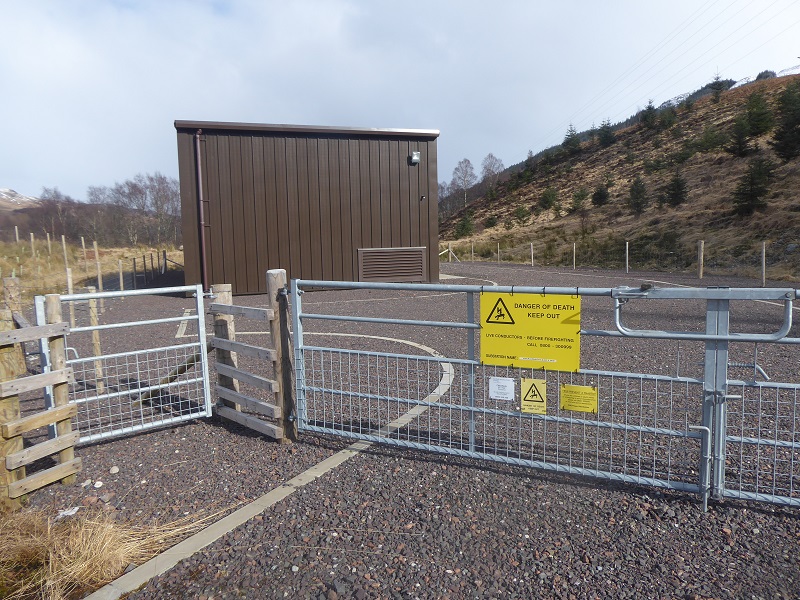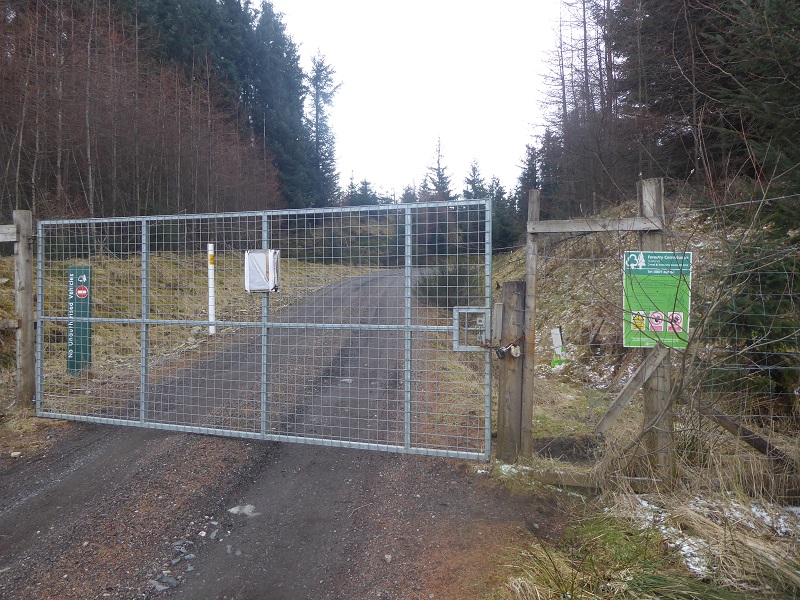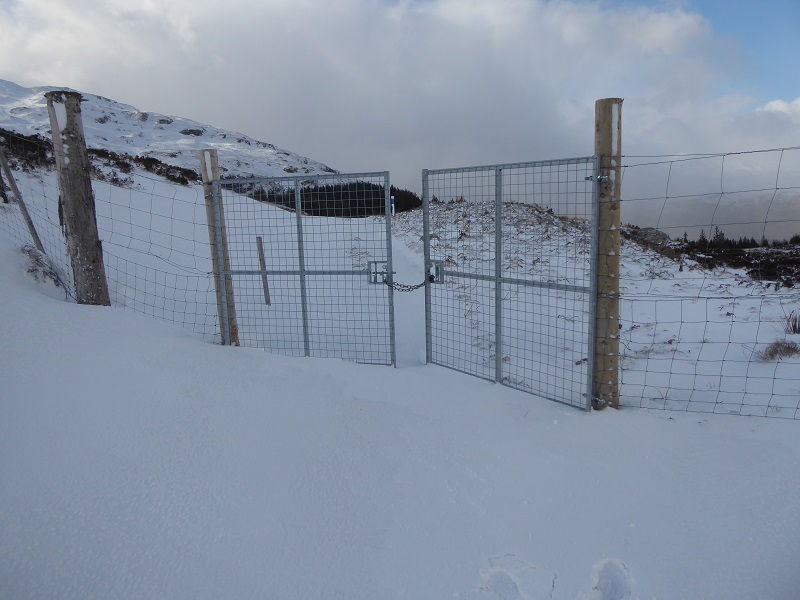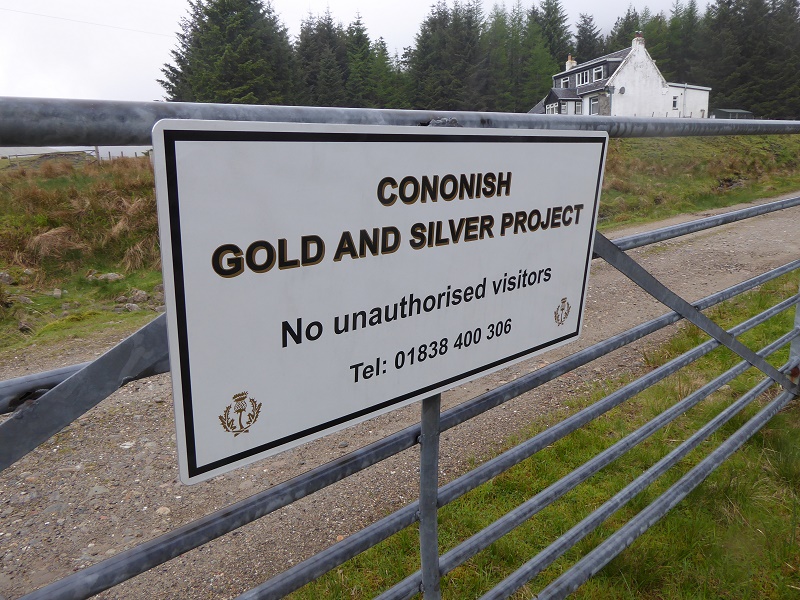
Just over three weeks ago, after deciding to retreat from a climb in Glencoe due to the wind, I decided to take a look at the Allt Choire Chaorach hydro scheme opposite the Auchessan schemes in Glen Dochart (see here). Within a couple of hundred metres I witnessed two extremes of how the Loch Lomond and Trossachs National Park Authority manages access, one exemplifying the highest standards, the other appalling and both apparently connected with developments. This post considers how these two extremely can be allowed to happen by the LLTNPA as a Planning Authority
The new electricity substation in Glen Dochart was required because of the new hydro schemes there. While well concealed from the road, in landscape terms it could be a lot better – the expanse of gravel being needlessly large (why does the LLTNPA only care about vegetation when its campers that create bare patches?) and giving a distinctly suburban feel. However, the access provision is amazing: there is not just the one pedestrian gate you can see from the photo but another on the other side of the main gate. And this for what appears to be a little used route.
However, less than a 100m further up the main forest track which is used to access the hydro scheme I came across this:

In fact just the sort of situation which their lordships in the Drumlean Case (see here) agreed presented an obstruction to the freedom of roam. And, while there is a possibility that forestry interests locked the gate above – though I do not recall the lock when I walked down the North East ridge of Ben More about three years ago – higher up there was another locked gate barring access to the new track across the hillside to three of the hydro scheme intakes:

This gate was easier to cross through the simple expedient of standing up on the chain and easing oneself through the gap. It was only after doing so that I realised there was another gate with stile further up the hillside above which it was not possible to see from below. There either needed to be a sign to this stile or preferably another crossing stile/gate installed here.
An explanation for this contradictory approach
The LLTNPA generally – and perhaps always? – seeks advice from its access team, that’s the people who led on the Drumlean case, and I believe they care passionately about access. In every hydro planning application I have read for the National Park, there are conditions included which are recommended by them to ensure that access is not obstructed during construction work and alternatives routes are created where required. Here, as an example, is what they required for the Allt Chaorach scheme:
Public Access Management Plan with additional detail on measures designed to minimise the detrimental effect on public access and to ensure public access is maintained including: warning signage content and locations (to be removed following completion of scheme); diversionary signage content and strategy; use of short / localised diversions; timing of works (vehicle movements to be restricted at weekends and bank holidays) and techniques and specifications for path reinstatement;”
The problem, however, what happens AFTER a development is completed. The planners do not seem to check or, if they do, simply don’t notice. The consequence is the locked gate and no access sign at Derrydarroch (see here) and the locked gates at the Allt Chaorach (which I will now report to the access team as an obstruction).
Its hard to avoid drawing the conclusion that the reason why a strong pro access line is taken at the application stage is that neither the LLTNPA as Planning Authority nor landowners want to annoy outdoor recreation folk who might then start objecting to applications. Hence, its in both their interests to involve the access team as much as possible at this stage. If you doubt me on this, consider why, of all the unlawful access signs I have now reported to the LLTNPA, only that outside the Cononish gold mine has been removed quickly:

Once an application has been approved however its a different matter. Perhaps the access team are not allowed to undertake check visits – its possible that like the public they are not even told when work has been “completed” – and planning officers either don’t visit or do not have the awareness to identify the issues (or maybe the landowners unlock all the gates before taking Park staff and other visitors round).
Whatever the explanation, this is an issue that needs to be addressed, particularly in light of the Drumlean judgement. Perhaps the LLTNPA could start issuing conditions to developments that on completion track gates can only be locked where pedestrian crossing points are installed and that NO signage may contravene the Scottish Outdoor Access Code.
“Pedestrian crossing points”? What about cyclists and horses – who have the same access rights as walkers?
Ever tried getting a fully packed bike through some of these kissing gates
Unload all luggage
Balance bike on rear wheel hold finger on brake
Open gate with spare hand
Tilt bike and release brake guide bike into inclosed area
Close gate
Wiggle about a bit and free.
The access of wheelchair users must also be addressed even in seemingly unaccessable areas
Colin, you are quite right on this and apologies my post did not refer to cyclists and horseriders for whom both gates would be unpassable, Nick
With regards to the gravel the llatnp are not bothered that campers erode the vegetation they just don’t want campers full stop and the thing is if the campers did not burn dead wood blah blah there would be very few picnic spots at all trees would block out light and the ground would be covered in dead wood with very little vegetation more fungus damp rotting leaves etc. travel round some of the lochs on a kayak and the best spots are where humans have cleared the ground chopped trees and worn down paths .what has happened is the campers have created the very spots they now have to pay for.
I had previously (March 2018) raised with LL&TNPA the access issue you highlight at the access route for the NE ridge of Ben More. They indicated a couple of weeks ago that the FC have agreed to reinstate a gate to allow proper pedestrian access so shall keep a close eye on when that is done.
Notwithstanding the resolution of the access issue, I was astonished, not having been in here for a few years, at the mess that has been made by the hydro works in what used to feel like quite a remote corrie, the round of which in winter I think from this access point over all the tops and Munros is an easily accessible but understated minor classic. Some of the remedial work to reinstate ground by the underground pipes and cabling has been very poorly carried out and bits of the verges on the as usual motorway-width main access track are also very poor.
Its great a gate is to be installed though this problem should never have been allowed to arise in the first place – as you say its an important access point for Ben More. When I visited much of the hydro work was under snow so hard to tell how good or bad a job had been done but the scars created by the forestry tracks were all too evident and I hope to cover in a further post.